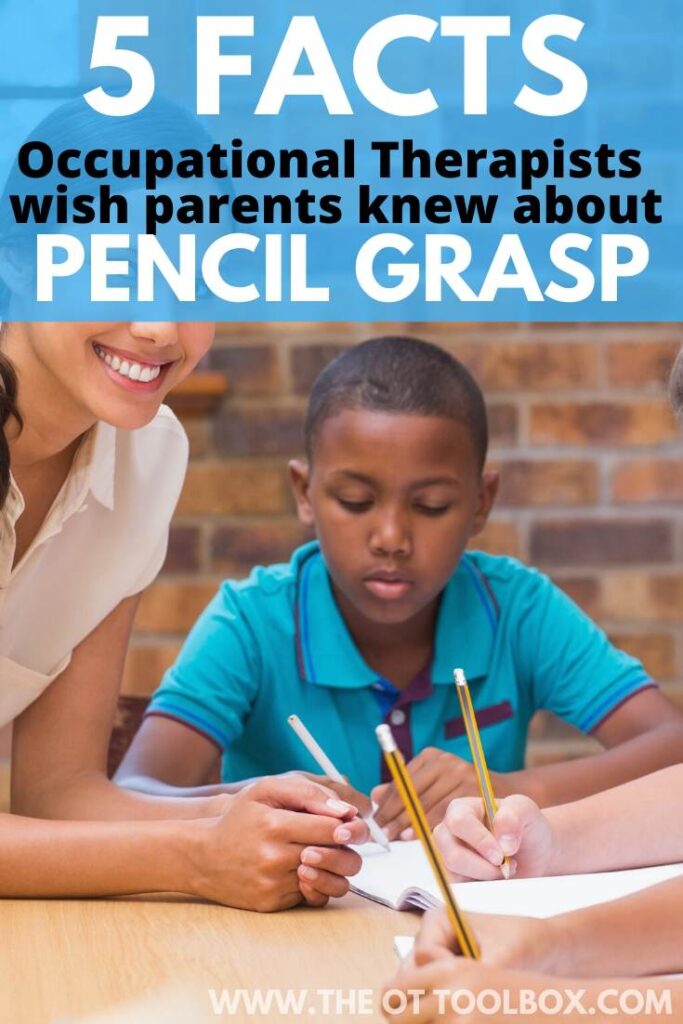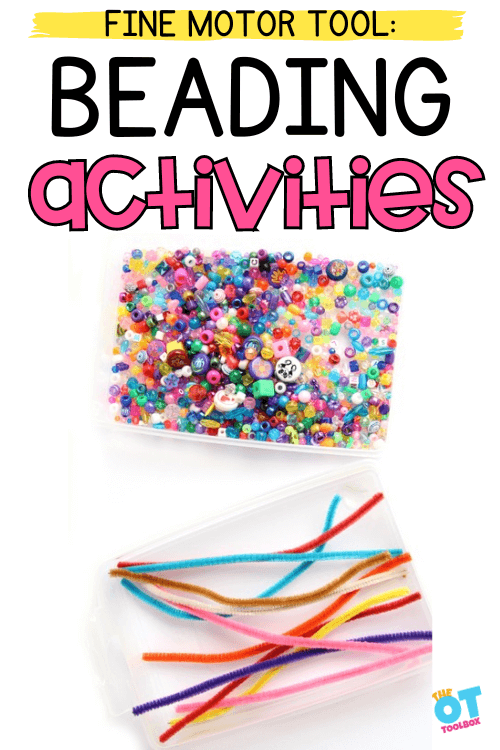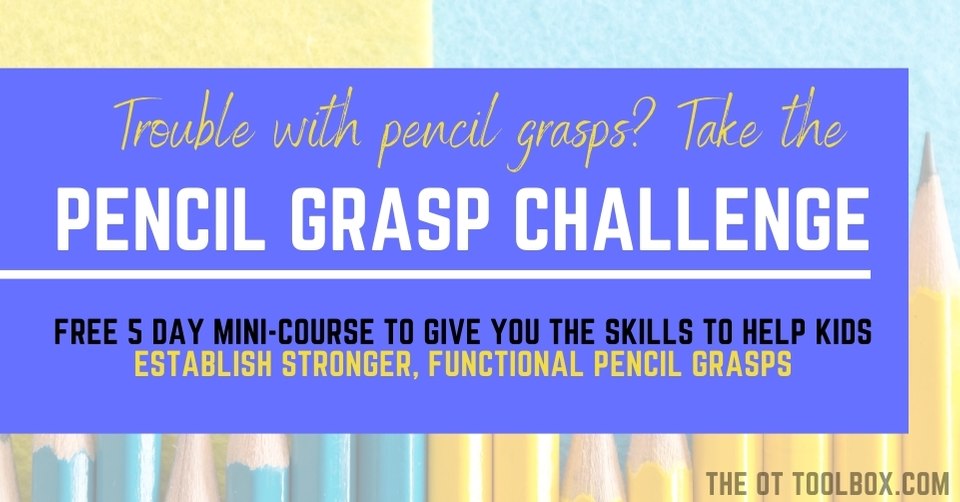Pencil grasp recommendations is a question that comes up a lot when kids have trouble with handwriting. In fact, many times occupational therapists receive a referral to check on a child with handwriting challenges and one of the things the teacher mentions is the child’s pencil grasp. Parents may have a lot of questions about pencil grasp development, too. They may wonder if their child is on track with their pencil grasp or how to help kids that are struggling with holding a pencil. The thing is that there is a lot that goes into gripping a pencil! Here are the top things that pediatric OTs wish parents knew about pencil grasp.

Pencil Grasp Recommendations
If your eyes glaze over when it comes to pencil grasp, how your child is holding a pencil, and how to help them, don’t worry! Here are the main points you need to know about pencil grasp development:
#1 Pencil grasp is not clear-cut.
In typically developing kids, children progress from using their whole arm to move a crayon, to using their forearm and wrist, to using their fingertips. That progression indicates upper bodies that support the arm, strong arms to stabilize posture, and refined fine motor skills.
In children with physical, cognitive, or neurodevelopmental considerations, grasp may not follow the age progression or demonstrate delays in progression. Other children skip developmental stages of pencil grasp for a variety of reasons.
#2 Limit the screens and offer more play.
Kids today are exposed to a variety or play activities (or lack thereof). They are also exposed to technology and screens from a very young age.
Think about it this way: when a young child holds a screen, they are missing out on time that other generations would have had to experience play and activity through their hands. They are also spending hours of time in some cases with a “screen grasp”. When a young child holds a screen, there is heavy weight through the ulnar side of the hand. The pinky side of the hand curves over and is in constant active grasping position to hold onto the screen or device.
That allows for a lot of strength in the pinky side of the hand, and time spent in the same position. The hand isn’t getting a variety of experiences to stabilize, manipulate which are important for in-hand manipulation and separation of the sides of the hand.
Then, the child is typically using the pointer finger to swipe. There isn’t the variety of grasp, manipulation, pincer development, and precision occuring.
Likewise, with screen use, there is a shift to thumb swiping and movements of the thumb on the screen. The thenar eminence gets a lot of the same motions. All of this adds up to a perfect storm of limited fine motor experience and lack of fine motor skills.
#3 Functional writing is most important.
This is one of the biggest take-aways that therapists want parents to know: A functional pencil grasp might not look like the traditional tripod grasp. Kids can hold their pencil with a thumb-wrap, cross-over, modified tripod, quadrupod grasp, or any of the many other variations…and STILL write in a way that is legible and efficient.
Research tells us that pencil grasps do not impact skills like letter formation or legibility. In the child using a mature pencil grasp (the fingers and hands do the work to move the pencil), variations of pencil grasp do not impact writing speed.
When speed is an issue, there is probably something else going on such as the child is using a transitional grasp pattern, sensory issues like heavy writing pressure are present, or motor planning issues like letter formation are occuring.
#4 Kids need play! Yes, it’s worth repeating.
Coloring, play dough, climbing trees, tumbling in the grass, and manueving on the monkey bars are important parts of pencil grasp development.
It’s true! The underlying skills that kids need to grasp the pencil and write occurs through play. The early stages of child development includes lots of crawling, and that’s an important stage!
Many times, we see fine motor difficulties in kids that skip the crawling stage. Sometimes the connection between crawling, fine motor exposure, and play isn’t apparent when it comes to pencil grasp.
Children need fine motor play to develop hand strength for precision and using those fingers. Kids need to climb and move to gain stability and control in their upper bodies so their shoulders and arms are able to support and stabilize distal mobility.
#5 Don’t rush the “picture perfect” pencil grasp.
So often, kids are rushed to hold a pencil perfectly. This assumption happens in classrooms everyday. Kids begin to write letters before they are developmentally able to hold and manipulate a pencil at a level that “looks correct” and in the meantime, miss out on valuable progression through pencil grasp stages.
We are seeing children start to learn to write letters in preschool and are pushed to write letters, words, and sentences in kindergarten. Going by developmental progression, this is before a child is developmentally able to manipulate a pencil with precision and mobility in the fingers and hand.
It’s OK to see a pencil grasp that isn’t perfect in preschool, kindergarten, or even the early grades. Keep offering fine motor experiences, play, and activities!
Need more pencil grasp help?
Try some of these fine motor activities to promote the skills kids need:
Use small pencils. Broken crayons and golf-sized pencils are perfect!
Try these games to build a better pencil grasp.
Improve pencil grasp with play.
JOIN THE PENCIL GRASP CHALLENGE!
Want to know how to fix a problem with pencil grasps? Need help knowing where to start when it comes to immature pencil grasps or a child hating to write because their hand hurts? The Pencil Grasp Challenge in open for you! In this free, 5 day email series, you’ll gain information, resources, specific activities designed to promote a functional, efficient pencil grasp.
The pencil grasp challenge is a free, 5 day mini course and challenge. During the course of five days, I’ll be teaching everything you need to know about the skills that make up a functional pencil grasp. You’ll learn what’s going on behind the inefficient and just plain terrible pencil grasps you see everyday in the classroom, clinic, or home. Along with loads of information, you’ll gain quick, daily activities that you can do today with a kiddo you know and love. These are easy activities that use items you probably already have in your home right now.
Besides learning and gaining a handful (pun intended) of fun ideas to make quick wins in pencil grasp work, you’ll gain:
- 5 days of information related to pencil grasp, so you know how to help kids fix an immature pencil grasp.
- Specific activities designed to build a functional pencil grasp.
- Free printable handouts that you can use to share with your team or with a parent/fellow teachers.
- You’ll get access to printable challenge sheets, and a few other fun surprises.
- And, possibly the best of all, you’ll get access to a secret challengers Facebook group, where you can share wins, chat about all things pencil grasp, and join a community of other therapists, parents and teachers working on pencil grasp issues.
Click here to join the Pencil Grasp Challenge.

Colleen Beck, OTR/L has been an occupational therapist since 2000, working in school-based, hand therapy, outpatient peds, EI, and SNF. Colleen created The OT Toolbox to inspire therapists, teachers, and parents with easy and fun tools to help children thrive. Read her story about going from an OT making $3/hour (after paying for kids’ childcare) to a full-time OT resource creator for millions of readers. Want to collaborate? Send an email to contact@theottoolbox.com.







